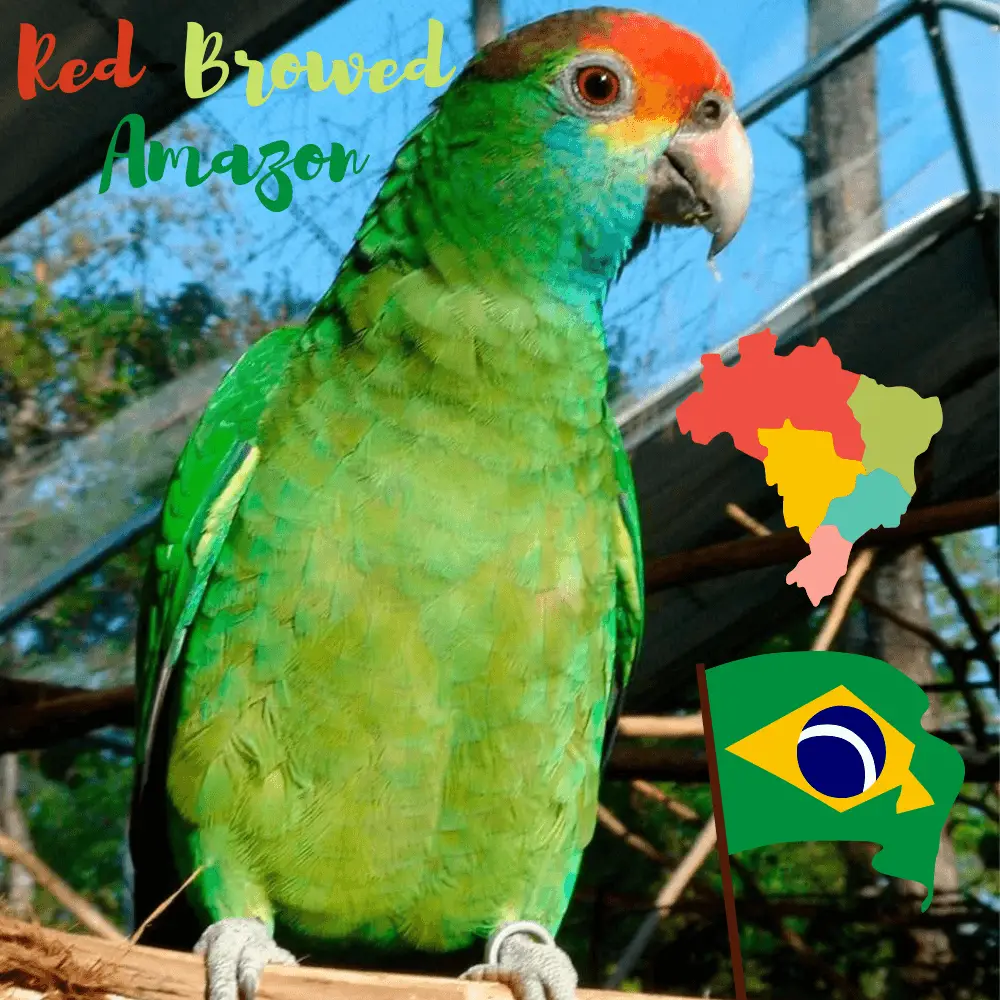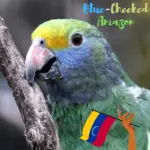
The Red-browed Amazon or Red-crowned Amazon (Amazona rhodocorytha (Salvadori, 1890)) has long been considered a subspecies of the Dufresne Amazon.
| Reign | Animal |
|---|---|
| Fork | Chordata |
| Class | Poultry |
| Order | Psittaciformes |
| Family | Psittacidae |
| Gender | Amazon |
Description
This bird measures about 34 cm.
The feathers of the forehead and cap are orange-yellow bordered with green. The lores are yellow and the cheeks have an azure hue.
This species is distinguished from the Dufresne Amazon by the bright red of the forehead and the smaller blue on the cheeks.
The red-browed Amazon measures about 34 cm with a mass ranging from 450 to 570g. The plumage of this bird is very colorful. Its body is mainly olive green, but the feathers of its forehead and cap are orange-yellow bordered with green. Its lores that in them are yellow. This species is distinguished from the others by the bright red on the forehead and the more reduced azure blue on the cheeks. The green trail is marked with red, blue, black and yellow. Immature have fewer reds on their heads.
Natural habitat
This bird is quite rare and is found only in east-central Brazil where they inhabit the dense and high forests of the interior. A population, which was once abundant, was discovered in northern São Paulo in the early 1990s but has declined significantly in recent years.
Captivity
In general, the breeding couple is housed in a large aviary 6m long by 2m wide and 2.5m high with a building 2m long by 2m wide and 2.5m high. The aviaries are made of metal and must be installed in such a way as to be protected by trees, or by windproof sails thus providing shelter from the heat of the sun, the wind, as well as the rain.
Longevity
This bird lives on average 50 years in captivity.
Feeding
The Red-browed Amazon feeds mainly on fruits, seeds, berries, and buds that they obtain from treetops.
Reproduction
During the breeding season, males and females defend their nests, usually installed in natural cavities in the trees of the primary rainforest.
The female will lay 2-5 eggs that will hatch about 26 days later.
The young will remain in the nest for another 3 months and will only be independent of their parents at the age of 5 months.
Status in the Natural State
They are rarely found in captivity.
Unfortunately, as only 10% of its tropical forest in eastern Brazil remains, and breeding of this species is very rare, reintroductions are not yet possible. in this region indicate that nest poaching and deforestation continue at an alarming rate
This species is endangered due to its very small habitat which is increasingly destroyed for agriculture.
In addition, the decline in its population is mainly due to illegal trapping for the sale of pet birds.
Behavior
In the 1930s, large herds of several hundred birds gathered at treetops along the banks of the Gregory River near Boa Nova outside the breeding season. Unfortunately, this species has lost most of its members since then. Nowadays, the largest flocks do not exceed 49 birds. They gather in groups to feed, to protect themselves from predators, and in dormitories.
Distribution
This rather rare bird is found in east-central Brazil (states of Alagoas, Bahia, Minas Gerais, Espirito Santo and Rio de Janeiro).
Conservation Beyond the Cage – Saving the Red Browed Amazon Parrot
SOURCE:Rare Species Conservatory Foundation
Related Articles:




















